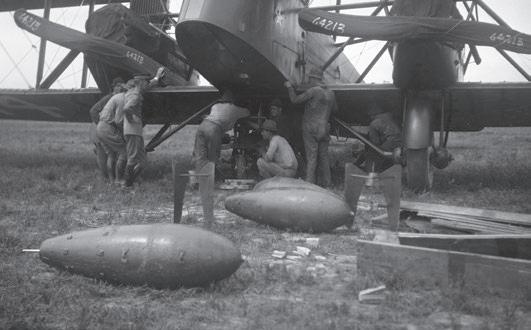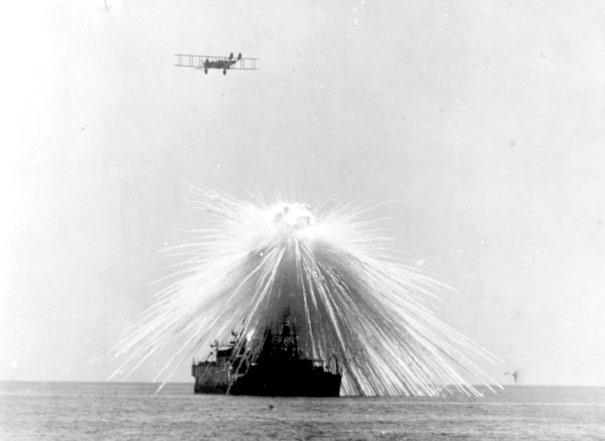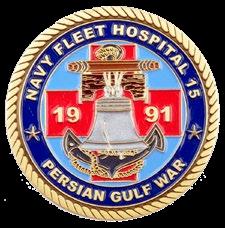
9 minute read
The Admirals Wept:
Billy Mitchell and the Atlantic Bombing Tests of 1921
By: Chris Kolakowski Museum Director
Advertisement
One hundred years ago powered flight turned eighteen years old. In 1921 the U.S. Air Force did not exist, rather it was a part of the U.S. Army as the U.S. Army Air Service. The Royal Air Force was three years old. Aircraft carriers were few in number and experimental, while planes had ranges of only a few hundred miles. As it had for centuries, naval strategy centered around the battleship as the core of a fleet. A century later airpower is an important part of the U.S. Armed Forces, and aircraft carriers have replaced battleships as rulers of the waves. This transformation began in significant measure because of the actions of aviators, led by Wisconsin’s General William L. “Billy” Mitchell, over a few weeks in the summer of 1921.
As the United States demobilized after World War I, it was clear that the airplane had introduced a new dimension of warfare. Some air power advocates, of which Mitchell became a leading light, argued for an independent U.S. Air Force which would render surface ships and land forces obsolete or irrelevant. At the same time, the U.S. Navy was undergoing a fleet modernization program with many battleships on the drawing boards. These plans and debates progressed against a backdrop of defense budget cuts and retrenchment, which meant air forces had to compete with ground and sea forces for shrinking resources. The outcome of these debates would have real-world consequences for the American military for years, if not decades, to come.
In the fall of 1920, the navy quietly tested aerial bombing on the obsolete battleship USS Indiana, anchored in Chesapeake Bay. The navy and marine aviators failed to sink her. “The entire experiment,” Wisconsin-raised Captain William D. Leahy reported, “pointed to the improbability of a modern battleship being either destroyed or completely put out of action by aerial bombs.” A furor arose when word leaked that the fliers were not using real bombs, rather sand and rock packages dropped on targets painted on deck. Congress got involved, and ordered the navy to prepare more realistic bombing tests in the Atlantic. These would use live ordnance and involve fliers from the navy, marine corps, and the army – a true exploration of air power’s potential effects on surface ships.

To take part in the tests, Mitchell assembled 1,000 men and 125 planes of the Army Air Service into the 1st Provisional Air Brigade at Langley Field (today Langley Air Force Base) near Hampton, Virginia. A period of intense training perfected his men in both level and dive-bombing techniques. Mitchell and his fliers also learned that near-misses could be as effective as direct hits, because of the resulting water pressure wave, which the fliers called a “water hammer.” Mitchell led from the front, and announced he would accompany all missions to the targets. He emphasized to his pilots that the test results would determine “the whole future of our force [the Air Service].”
For targets, the navy provided German ships surrendered after World War I: submarine U-117, destroyer G 102, cruiser Frankfurt, and battleship Ostfriesland. They would be anchored fifty miles off the Virginia coast, a two-hour flight time from Langley. All were modern ships and combat veterans. Ostfriesland in particular was ten years old and exceptionally well-designed to take damage and stay afloat. The army and navy senior leaders negotiated rules for the tests, limiting the size of bombs and tactics that could be used. A control party aboard USS Shawmut would direct the tests, while VIPs aboard transport Henderson and the rest of the Atlantic Fleet looked on. Naval parties would board the ships after a certain number of hits to assess damage, and if needed, the Atlantic Fleet would finish off any target ships that failed to sink.

The first test was U-117 on June 2. Two passes by three navy seaplanes sent her to the bottom in minutes, the speed of destruction surprising all observers. A few days later Mitchell’s flyers went after G 102, which they had been allowed to attack with a fairly free hand.

Continued on page 16
Shawmut (CM-4) 1907 at left, photographed off the Virginia capes during aerial bombing experiments in which the Ostfriesland was sunk as a target. Shawmut, renamed Oglala in 1928, served as a control ship in the tests. This photo was taken on 21 July 1921.
Naval History and Heritage Command photo.
After strafing and topside damage by pursuit planes, Mitchell’s bombers dropped accurate strikes on and around the ship, including a bomb down the stack. G 102 broke in half and sank quickly. On July 18, Frankfurt succumbed to similar tactics, with the initial waves provided by navy and marine corps flyers. The first two targets were lightly-armored, whereas Frankfurt was much better protected. Nonetheless, the fact remained that planes alone had sunk three modern ships. Despite these successes, the biggest prize still needed bagging. “This was our real test,” recalled Mitchell in 1925. “If we could not sink this great ship the efforts against the other smaller vessels would be minimized and the development of air power against shipping might be arrested, at least for the time being.” On July 20 the strikes against Ostfriesland commenced. navy and marine planes raked Ostfriesland’s decks with smaller bombs and were just flying away when Mitchell and his planes arrived in the afternoon. After circling for almost an hour while damage was assessed, the Army fliers were allowed to attack. Thousand-pound bombs struck on and around the ship, leaving her wounded but afloat. Damage parties went aboard and found her listing and down by the stern, with flooding.

Mitchell’s planes returned the next morning, July 21. At 8:32 Lieutenant Clayton Bissell led a string of six planes into an attack, scoring several hits with thousand-pound bombs and leaving Ostfriesland a wreck. Damage parties went aboard again and confirmed that in wartime, the battleship may have been able to make it home, but was almost certainly combat ineffective. Three hours later Mitchell returned with ten planes each carrying two-thousand-pound bombs. They dove in succession and struck accurate hits around the ship, which created the “water hammer” effect and broke open Ostfriesland’s hull. After six bombs it was clear no more were needed. “When a death blow has been dealt by a bomb to a vessel,” recalled Mitchell, “there is no mistaking it.” Captain St. Clair Streett, Mitchell’s rear-seat observer, stood up with waving arms and yelled, “She is gone!”
The wounded battleship listed further to port. Her stern dipped lower, and sluggishly she rolled onto her port side. Within a few minutes she was upside down. Her stern sank and the bow clawed at the sky before descending. A minute later Ostfriesland was gone, leaving a bubbling spot of water on the surface. A plane dropped a bomb into the bubbles to punctuate the victory. Several admirals wept as Ostfriesland slid beneath the waves.



The news of the sinking shocked military circles. For airpower advocates, it was a huge boost. Mitchell repeated his performance in nearby waters against USS Alabama in September 1921, and two years later against USS Virginia and USS New Jersey. Soon aircraft and air power assumed larger roles in U.S. strategy. Mitchell regarded these tests as definitive and said that “aircraft constitute a positive defense of our country against invasion.”


Many of the participants in the tests went on to have prominent careers. Streett later commanded bomber operations in World War II and was instrumental in forming Strategic Air Command. Henry H. “Hap” Arnold flew a plane in the tests and later was commander of the U.S. Army Air Forces in World War II. Clayton Bissell helped develop air doctrine and commanded Tenth Air Force in World War II. Among the navy and marine corps participants, Roy Geiger and Francis Mulcahy pioneered Marine Corps aviation, holding prominent commands in the Pacific, while Felix Stump did the same for the Navy. For all of these men, participation in the bombing tests of 1921 was a major professional milestone.
For Billy Mitchell, the sinkings off Virginia in 1921 proved a zenith of his career. His achievement reinforced the case for aviation’s future promise. Naval aviators successfully pressed for development of aircraft carriers and air units for the fleet, while army pilots used Mitchell as a guide and inspiration for their doctrine and organization through the World War II years and beyond. The effects of both of these efforts are still apparent in the navy and air force today.
The lessons of the bombing tests remained open for some debate in naval circles, chiefly because the ships were stationary and not defending themselves. Mitchell’s feat was partly replicated in 1940 by the British raid on Taranto and in December 1941 by the Japanese raid at Pearl Harbor, but in both cases the target ships were stationary in harbor. The sinkings of HMS Prince of Wales and Repulse by Japanese aircraft off Malaya on December 10, 1941, made it clear the age of the battleship as dominant naval vessel was closing. The destruction by American planes of Musashi in October 1944 and Yamato in April 1945, the most powerful battleships afloat, removed any final doubt on that score. What Mitchell’s successes in 1921 foreshadowed had come to pass.
A century ago this summer, Wisconsin’s Billy Mitchell changed military aviation forever. In the process he inspired generations of fliers of all services, and left a lasting mark on warfare still visible today.
Thirty years ago this January, U.S. Navy Fleet Hospital 15 deployed to the Persian Gulf in support of Operation Desert Storm, arriving just as the ground war began. Within days of their arrival, the modular 500 bed facility located near Al Jubail, Saudi Arabia was assembled and ready to provide land-based medical and surgical care for the U.S. Marine Corps. Among the 940 people sent to run the self-contained facility was Captain Steven L. Oreck, a career medical officer in the United States Naval Reserve who specialized in orthopedic surgery.



Oreck was born in New York City, and was raised there and in New Orleans, Louisiana before entering service in December 1969 while attending the Massachusetts Institute of Technology (MIT). Following his graduation in 1970, Oreck reported for active duty in July and was commissioned as an intelligence officer through the Aviation Officer Candidate School at Naval Air Station Pensacola in November. After release from active duty in 1973, he returned to MIT for graduate work in chemical engineering followed by Louisiana State University for medical school. After receiving his MD in 1979 Oreck transferred to the Navy Medical Corps and was serving
By Andrea Hoffman Collections Manager
as chief of orthopedics at a field hospital in New Jersey when Kuwait was invaded in August 1990.
At that point, Oreck was told it was not a question of if, but rather when he would be called up. The logistics of moving all the necessary hospital equipment— including medical supplies, food, and the structure itself—delayed his deployment for several months.

In the first of two oral history interviews Oreck completed with the Wisconsin Veterans Museum, he explained that after their arrival, “…the equipment was there and we just sort of fell on the equipment…[it] is in all of these boxes, these steel containers, and then you go ahead and open them up and build a hospital… it’s got six OR beds and eighty ICU beds and 420 regular beds…It was all modular like Legos.”
He went on to explain, “The way these things were designed is you’d open them up out of the can, and the only thing you need to get going was water and fuel and blood. Other than that, you had enough medical supplies and food and everything to run this for the 950 people of the crew plus 500 patients for sixty days. It was all prepackaged.”
Over the next month, Fleet Hospital 15 treated about 85% of the marines that were wounded as well as U.S. soldiers and airmen and foreign servicemembers from England, France, and Senegal. After the ground war ended in February and other U.S. Navy medical facilities covered Saudi Arabia, Oreck was asked to stay on as doctor for the Explosive Ordnance Disposal (EOD) group in Kuwait City. The British, American and Australian EOD dive team was charged with removing unexploded ordnance and mines from the harbor, and due to the inherent hazards of their work, required continued access to medical care.
This British two-tone Disruptive Pattern Material (DPM) bush hat was acquired through trade with a doctor at a nearby Collective Protection (COLPRO) field hospital. It is shown along with a French Ration de Combat and Australian Combat Ration Pack (CRP) Oreck traded for while in Kuwait City. V2007.57.2, V2008.78.10, V2008.78.11

While in Saudi Arabia, FH15 traded medical supplies with a British hospital for this muchneeded external fixator. Oreck brought it home as a souvenir. V2004.49.5
It was during this period Oreck traded for some of his more interesting keepsakes from his tour, including a British bush hat and Australian and French rations, the latter the result of him being the only naval officer in Kuwait who spoke French. Perhaps the most unusual souvenir is an external fixator kit used to stabilize broken bones that he traded medical equipment for with a British hospital while in Saudi Arabia. After his return stateside at the end of April, Oreck’s civilian career as an orthopedic surgeon led him to Madison, where he went on to work as a professor of orthopedics and plastic surgery at the University of Wisconsin School of Medicine until his retirement in 2008. He also remained in the Naval Reserve for another 16 years, amongst other assignments serving as regimental surgeon for the 23rd Marine Regiment and as a medical watch officer at the Combat Operations Center at Headquarters, U.S. Marine Corps in Washington, D.C. during Operation Iraqi Freedom. Oreck retired as a captain on January 1, 2007.


Afterward, Oreck earned his M.A. in History at the University of Wisconsin-Madison and was pursuing his doctorate, writing his dissertation on the history of military medicine when he passed away on August 11, 2019. We are grateful for all Oreck’s many contributions to the Wisconsin Veterans Museum.









